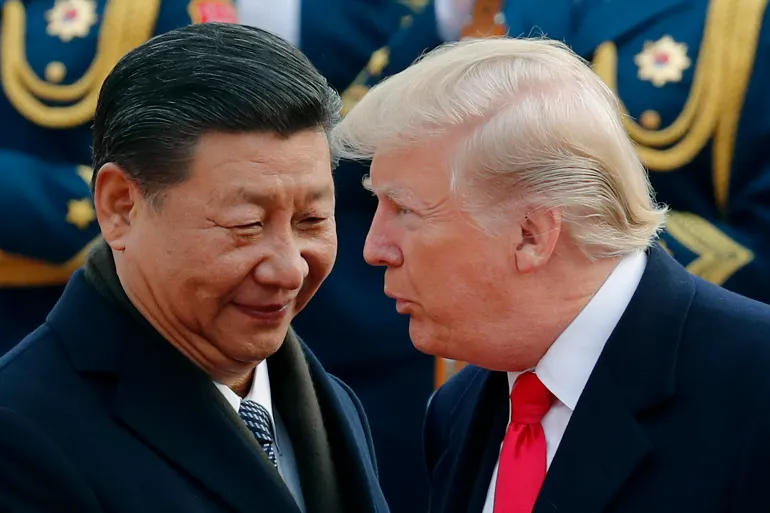China Slaps 34% Tariff on U.S. Imports in Retaliation to Trump’s Trade Strike — White House Holds Firm
The economic battle between the United States and Communist China has entered a new and volatile chapter. Just days after President Donald Trump announced sweeping reciprocal tariffs on dozens of trading partners, Beijing has retaliated with a massive 34% blanket tariff on all U.S. goods, set to take effect April 10, 2025.
This move marks one of China’s most aggressive trade maneuvers to date and underscores the deepening standoff between the world’s two largest economies. But far from backing down, President Trump responded swiftly and unequivocally—signaling that this time, America is holding the line.
China’s Retaliation: Sweeping, Strategic, and Symbolic
The announcement, made through the Chinese Ministry of Finance, accuses the United States of engaging in “unilateral bullying practices” and “undermining the stability of the global economy.” Translated statements suggest the CCP views Trump’s April 2 reciprocal tariff order as a violation of international norms—though the irony was not lost on American analysts.
Among the key details:
- 34% tariff on all U.S. imports into China
- Effective April 10, 2025, at 12:01 a.m. Beijing time
- Goods already en route by that time and arriving before May 13, 2025, will be exempt
- China demands the U.S. “immediately cancel” its tariffs and return to “mutually beneficial” dialogue
The CCP also took additional steps to escalate pressure:
- Blacklisting 11 U.S. companies under the “unreliable entities” designation
- Adding 16 more American firms to its export control list
- Blocking exports of rare earth minerals, crucial to U.S. electronics and defense sectors
- Filing a formal complaint with the WTO, a largely symbolic move given prior precedents
Trump: “China Played It Wrong. They Panicked.”
President Trump responded immediately on Truth Social, dismissing China’s retaliation as a sign of weakness:
“CHINA PLAYED IT WRONG, THEY PANICKED — THE ONE THING THEY CANNOT AFFORD TO DO!”
Insiders confirm that the White House expected a reaction from Beijing but sees China’s countermeasures as economically self-destructive—a move made under pressure rather than from strength.
Senior administration officials pointed out that China remains heavily reliant on U.S. markets and investment, especially as it navigates slowing domestic growth, a collapsing real estate sector, and ongoing capital flight.
Tariff War or Trade Realignment?
The Trump administration has made clear that tariffs are not just punitive—they’re strategic. The 10% baseline tariffs implemented this week were meant to rebalance long-standing trade inequities that have drained American manufacturing, undercut workers, and given foreign powers disproportionate access to the U.S. market.
“This isn’t a trade war. It’s a course correction,” said a senior White House trade adviser. “China has been playing by a different set of rules for decades—and the U.S. is finally responding with strength.”
The administration also released a country-by-country tariff comparison chart highlighting China’s prior 67% average tariff on U.S. goods, while benefiting from minimal reciprocal duties when exporting to the U.S. under pre-2025 policies.
Political and Market Reaction
While financial media outlets sounded alarms—predicting everything from supply chain collapses to inflationary spirals—markets have so far been more measured than expected. Cryptocurrencies and select industrials even saw modest gains, while manufacturing and domestic energy sectors expressed cautious optimism about potential reshoring benefits.
Meanwhile, GOP lawmakers have largely backed Trump’s move, calling it long overdue.
“This is exactly why we sent Trump back to the White House,” said House Majority Leader Steve Scalise. “No more bending the knee to foreign adversaries. It’s America first—again.”
Democrats have accused the administration of “provoking an avoidable confrontation,” but critics note that the Biden administration failed to make any progress in deterring Chinese trade abuses during its tenure.
What Happens Next?
While Beijing’s 34% tariff sends a strong message, it may be economically unsustainable over the long term. China’s export-driven economy is already facing structural headwinds, and its attempt to pressure the United States could backfire if American companies shift operations elsewhere—or if U.S. consumers double down on Buy American initiatives.
President Trump has indicated he is open to negotiations, but only under terms that prioritize American sovereignty and fairness. Until then, the administration is expected to maintain and potentially expand tariff enforcement, including through audits, import controls, and incentives for domestic manufacturing.
Conclusion: China Blinked—And It May Blink Again
The CCP’s retaliatory tariffs may generate headlines, but they reveal a deeper vulnerability. For the first time in decades, the United States is using its economic might with purpose—and the world, especially China, is watching closely.
Trump’s tariff strategy is about leverage, rebalancing, and restoring strategic autonomy. Whether Beijing realizes it or not, the rules of global trade just changed—and this time, America isn’t playing second.

